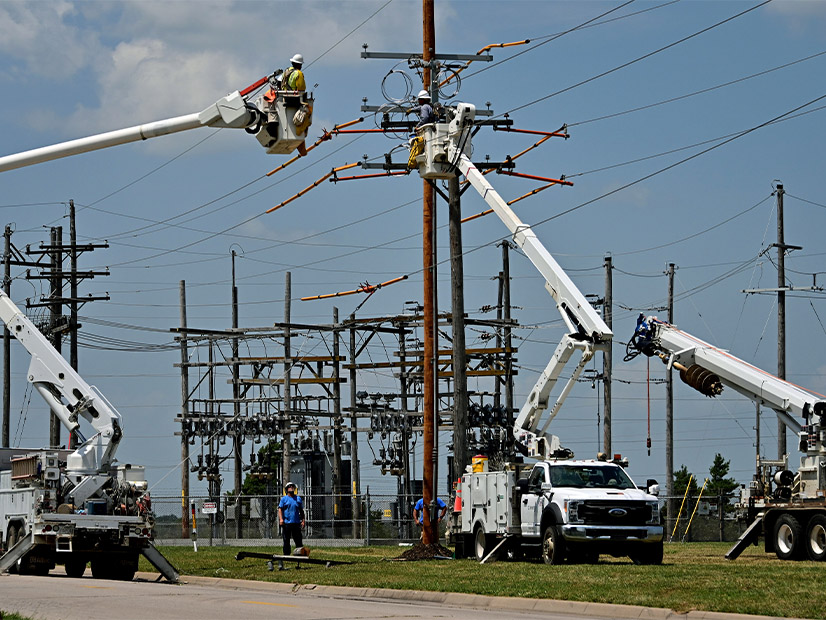
FERC on Dec. 19 found SPP mostly in compliance with the directives of Order 881 (Docket No. ER22-2339-001).
But FERC directed SPP to clarify what entity is responsible for developing forecasts of ambient air temperatures. Those are used to calculate the ambient-adjusted ratings (AARs) and seasonal line ratings, but FERC said SPP’s proposed wording was ambiguous.
FERC rejected a request by SPP’s independent Market Monitoring Unit (MMU) to direct SPP to include language that places additional candor requirements on transmission owners. Order 881 did not impose such a requirement, FERC said, and a compliance filing is not an appropriate proceeding to address that issue for the first time.
FERC Order 881, issued Dec. 17, 2021, directed that transmission providers end the use of static line ratings in evaluating near-term transmission service, a move the commission said would improve accuracy and transparency and increase grid use.
Order 881 requires transmission providers to employ AARs for short-term transmission requests — 10 days or less — for all lines that are impacted by air temperature. It requires seasonal ratings for long-term service.
SPP submitted its first compliance filing July 12, 2022. In response, FERC issued its first compliance order May 18, 2023, finding several faults:
“SPP did not address whether or how its compliance filing requires SPP to use updated AARs as part of any market process associated with the day-ahead and real-time markets, including reliability unit commitment, as well as any look-ahead commitment processes or other such processes, as required by Order No. 881.”
Nor, FERC found, did the first filing address the requirement that RTOs and ISOs use AARs as the relevant transmission line rating for any seams-based transmission service offered.
FERC directed SPP to submit revisions as a second compliance filing by Aug. 1, 2023. SPP filed July 28.
The MMU filed its motion to intervene and protest Aug. 17. It said SPP’s proposal did not demonstrate how it would use AARs in its market processes and said such information should be included in the tariff.
The MMU also said the second compliance filing does not indicate which transmission line rating — AAR or seasonal — will be used for each of the integrated marketplace processes, and particularly the transmission congestion rights market.
The MMU argued that, given the frequent changes in temperature forecasts and line ratings, SPP must transparently set the time horizon for the ratings used in each market process.
SPP disagreed with the MMU, and for the most part, so did FERC.
In the Dec. 19 order, FERC said neither Order 881 nor the first compliance order directed SPP to use or to clarify specific line ratings in transmission congestion rights markets.
FERC also disagreed with the MMU’s assertion that the second compliance filing did not explain how SPP would use in its market processes a replacement line rating when it identifies an inaccuracy.
“Given that the tariff provides for use of seasonal line ratings as a default recourse rating when an AAR is unavailable,” FERC wrote, “which would include when there is an identified inaccuracy that cannot be resolved, we find that the tariff provides for replacement line ratings if an AAR inaccuracy is identified.”
The MMU further argued that the second compliance filing does not clearly delineate transmission owner and transmission provider roles and does not address transparency and accuracy of transmission line ratings and methodologies. But FERC said it had not imposed any such candor requirements on SPP.
FERC did not completely disagree with one of the MMU’s protests — the request for a transparent time horizon. That is not required, FERC said, but Order 881 does require transmission providers to explain their timelines for calculating or submitting AARs as part of their compliance filings.
SPP failed to do this in its first compliance filing, FERC said, so in its first compliance order, it directed SPP to submit by Nov. 12, 2024, a further compliance filing that explains those timelines.
In its order Dec. 19, FERC also accepted four tariff wording revisions SPP had proposed in its second compliance filing:
-
- “[SPP] must establish and maintain systems and procedures necessary to allow Transmission Owners to electronically update Transmission Line Ratings at least hourly.”
- “If an AAR for any interval is unavailable, Transmission Provider must use a recourse rating as the appropriate Transmission Line Rating.”
- “In the event there is disagreement among entities on the calculated AAR of a tie line between neighboring Transmission Owners, the Transmission Provider must use the most limiting AAR in order to ensure reliability and that thermal limits are maintained.”
- The term “available transfer capacity” will be changed to “available transfer capability” in the definition of Near-Term Transmission Service.
With FERC’s order, the second compliance filing becomes effective July 12, 2025, subject to the additional steps FERC directed regarding AARs.


